This post contains affiliate links.
Marie and Ben met while backpacking in Costa Rica, and somewhere along the way fell in love, Ben says. After living with the bare minimum for months on end during their adventures, renovating an old school bus and living tiny didn’t seem so far-fetched.
So now they’re the proud owners of Gus (@littlegusthebus), their teal and white renovated school bus that currently lives on a large farm property in Canada. The couple is taking a leap of faith trying to launch a wood-working business from the workshop/barn on the property.
The interior of this traveling home is coated in cream and dark wood and features the most adorable tiny wood-burning stove. While the couple is having a tough time sans-shower during COVID-19 (the gyms are all closed!), they are making the most of this quiet time. Check out the pictures of their bus below, and read our interview with the couple after the pictures.
Don’t miss other amazing stories like this – join our FREE Tiny House Newsletter for more!
Wood-working Couple’s Bus Life in Canada
Here’s a fantastic “before and after” of the bus’ interior.
And then an “after and before” from the opposite view.
There are so many great details, but the window coverings are particularly neat.
Their back door opens up on nice days to allow a wonderful breeze.
How cool is it that they included this fun swing?
The wood-work on this closet area is such a lovely detail.
When needed, the table flips up for more room. Great feature.
A glimpse of how amazingly organized their cabinets are!
This stove is just the cutest thing. They’ve had it going nonstop lately since there’s still snow right now!
The couch becomes their bed (or lounging area) at night.
Home is where you park it for this couple.
Little bus, huge silo! Read our Q&A with the couple after this photo.
Interview with Ben from @LittleGusTheBus
Who are you and where are you living?
We are Marie and Ben, a French girl and a Canadian guy, living in our converted school bus, named Little Gus. We are located in Guelph, west of Toronto, Ontario, Canada.
Why did you decide to go tiny? What are you hoping to get out of living tiny?
That is a tricky question, as it was more of an organic path to tiny living rather than a conscious decision.
We met five years ago in Costa Rica. We were backpacking across Central and South America. Marie had a plan, Ben had a tent! We ended up traveling together for five months and falling in love somewhere along the way. I guess our journey began with a form of minimalism, with very little, yet everything we needed in our backpacks.
Our lifestyle has always been that way, often on the move, possessing little. The less stuff, the more freedom! From minimalism to tiny living, there is only one step. And Marie is from Paris, where living tiny is not a choice!
What benefits are you experiencing after going tiny? What about some challenges?
Living tiny allows us to have freedom of space and time, but also frees our minds. Money doesn’t drive our lives, and our house on wheels doesn’t limit us to living in one place. Having less is worrying less. We don’t wonder where things are, we don’t waste time cleaning rooms that we never use, or desire something that we won’t be able to afford. It brings us peace, it encourages us to stay focused on the essentials and to feel more grounded. The community matters so much! We rely on each other more, we exchange more, we share more.
The downside of tiny living is the lack of private space. We don’t have the same rhythms in life, and our sleeping patterns don’t match. We only have one space, so you can’t start your day without waking the other one. Respecting your personal rhythm and your partner’s space is a challenge and it is important to try to find the middle ground. Definitely the biggest challenge of all!
How long did it take to finish your bus? How did you build your bus?
We bought a retired school bus from Boston (we were looking for a specific model). It took us a few months to sort out the paperwork to get it across the border to Canada. We converted it in about four months, during the summer of 2018 (4 months was AMBITIOUS!). But as any DIY person knows, there is always an ongoing project, something to fix or improve!
We didn’t have much of a layout, just some ideas we found online. Ben is the ‘act first, think second’ personality and Marie is the opposite, so there were a lot of ‘lively conversations’ about the renovation! Ben is very handy and we were both willing to spend all our free time on the build, so we were able to do everything by ourselves, except installing the solar panels (which in hindsight we could have done too).
Converting a bus presents some different challenges as it is a moving vehicle! So the design and construction had to account for that.
Are you comfortable sharing how much you spent on your bus?
We bought as much as we could second hand and got some help from friends and family. We rushed through the build, we made a bunch of mistakes that cost us some time and extra money. But that is life!
Here is approximately what we spent in American Dollars:
- Bus+registration+taxes: $4,500
- Conversion: $12,000
- Mechanical repairs: $7,000
We knew we would have to do some repairs, but we definitely didn’t expect that much. Our bus was freshly retired, and only ten years old. Some of the problems were very unexpected, like a crack in the rear differential and blown brake lines. Definitely worth it in the end, and we love the life we have now!
How did you find a place to park and live in your bus?
We are currently parked on a large farm property. We were looking for a place to park the bus and set up a workshop. We built our woodshop in an old barn, and we parked the bus alongside a field. We are surrounded by nature, it is our ideal location for now! We pay rent, but mostly for the workshop.
What are utilities/costs like month to month in comparison to your former life?
Our monthly expenses for the bus are pretty low, as we have a fireplace to heat ourselves, and solar panels and propane for our water heater, oven, stove, lights, plugs etc. Our main expenses are actually our cell phone plans to have enough data without wifi, and the insurance for the bus. We are definitely saving money with our lifestyle!
What makes your tiny house special? What is your favorite part of your bus?
For us, living in a school bus is the best way to be deeply connected to nature. We made sure to keep the eighteen windows and doors, and we even added a skylight! We can feel everything happening around us. The sunrise, the moonlight, a rabbit hopping around, some deer or wild turkeys in the field, coyotes at night, a storm brewing… it is magical!
In winter, our favorite spot is by the fireplace, a tiny wood stove that brings warmth and coziness to our home. But in summer, we spend more time on the rooftop deck, with a drink and the sunset!
What helpful advice would you give to others interested in going tiny?
Take your time to find what works for you. Try to downsize for a weekend, and see how you feel about it. Get inspired by others, and find your own path and your own lifestyle. Trust yourself. There are no rules!
For those who are planning to build their tiny home: enjoy the process! Don’t rush through it, don’t overlook some boring job, take your time, ask questions, do enough research. You will never regret having spent too much time on insulation, plumbing or electrical, but the opposite is very true!
Take care of yourself and the people helping you in that process, spend some time away from the build once in a while. Take pictures to remember, and celebrate the small victories!
Feel free to contact us if you have questions about the build, lifestyle, or just to exchange with us.
What’s been the hardest thing about quarantine in a tiny home?
We are way more dependent on city conveniences than it seems. For example, we shower at the gym, use wifi in cafes to work and connect with our friends and family back in France. The access to those simple conveniences is now gone. Trying to manage a stock of food to limit the trips is also challenging, as we have a tiny fridge and no extra space. We don’t have access to drinkable water, so the empty shelves in the stores give us some trouble.
What have you been doing to stay sane?
We are lucky enough to be surrounded by nature. We go for walks, and try to embrace the new slow pace. We are also taking the time to set up a woodshop, and think about ways of creating our own jobs. It doesn’t always work, so we are open to suggestions!
What adjustments have you had to make your tiny house quarantine-friendly?
This is a tough one! Our ‘new’ bus life is more time consuming and challenging than ever. Not much we can do about it, except embracing the situation. We are working on a better system for our outdoor shower though (first step: installing a curtain for more privacy… mostly from the deer in the field).
How does a tiny home make social distancing either more difficult or perhaps easier?
When I read about other people’s experiences during their confinement, I realize that we have one advantage: we are used to being together all the time and not having any private space. So having to stay home and sharing everything with your spouse seems normal for us.
The difficult part: a tiny house is not built to stay in all day long, but to connect with others and be outside. We are in Canada, so the weather is not too friendly for now (still snowing last night). Also for two people in 11 square meters, you have to be good at recovering from arguments!
What new things have a quarantine in a tiny house let you do?
I don’t think that it is specific to living in a tiny house, but being confined helped us re-evaluating our needs and focusing on what matters the most. We also found an unexpected great comfort from the skoolie and tiny house communities. This is the magical aspect of that pandemic: realizing we are all in this together and seeing everyday help and support flowing. Let’s remember we are the fortunate ones, to be bored in our own house.
Learn more
You can share this using the e-mail and social media re-share buttons below. Thanks!
If you enjoyed this you’ll LOVE our Free Daily Tiny House Newsletter with even more!
You can also join our Small House Newsletter!
Also, try our Tiny Houses For Sale Newsletter! Thank you!
More Like This: Tiny Houses | Buses | THOW | Two People and 5 Rescued Animals (Including Two Bunnies) Travelling in a Renovated Bus! | Mom Living In A School Bus Conversion With Her Two Kids
See The Latest: Go Back Home to See Our Latest Tiny Houses
This post contains affiliate links.
Natalie C. McKee
Latest posts by Natalie C. McKee (see all)
- Hygge Dream Cottage Near Quebec City - April 19, 2024
- She Lives in a Tiny House on an Animal Sanctuary! - April 19, 2024
- His Epic Yellowstone 4×4 DIY Ambulance Camper - April 19, 2024

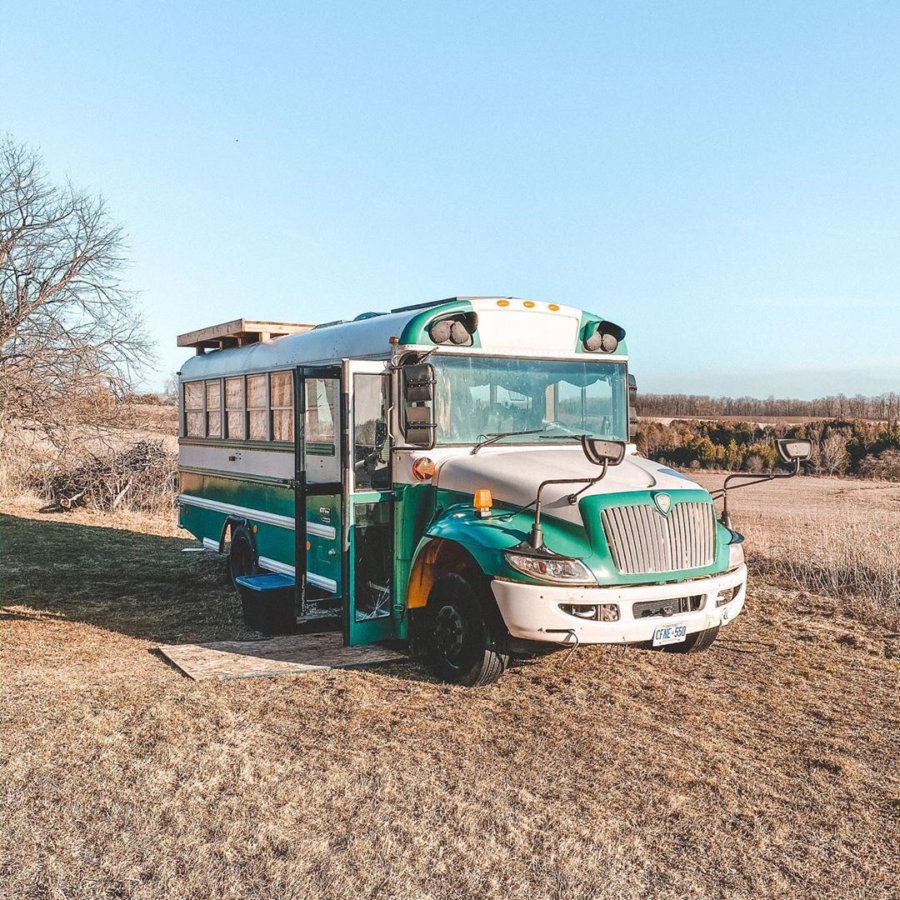
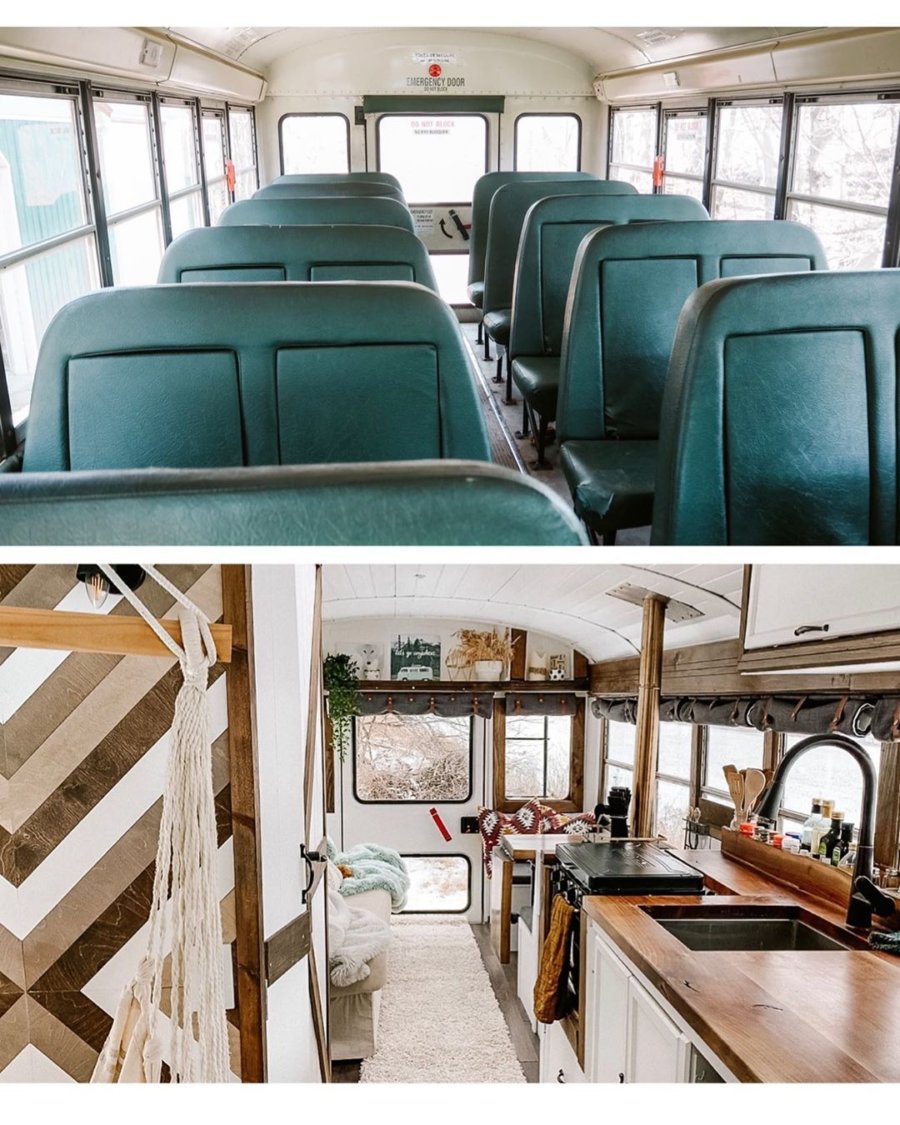
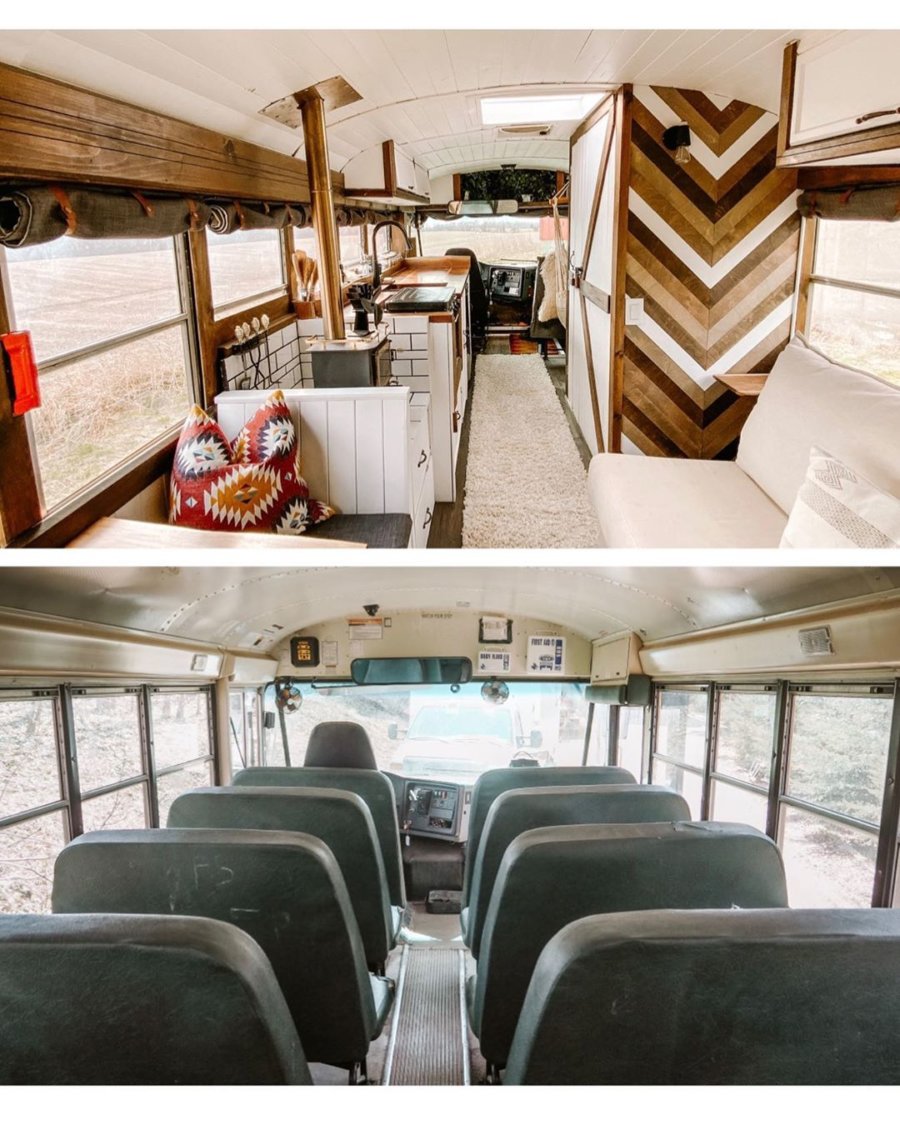


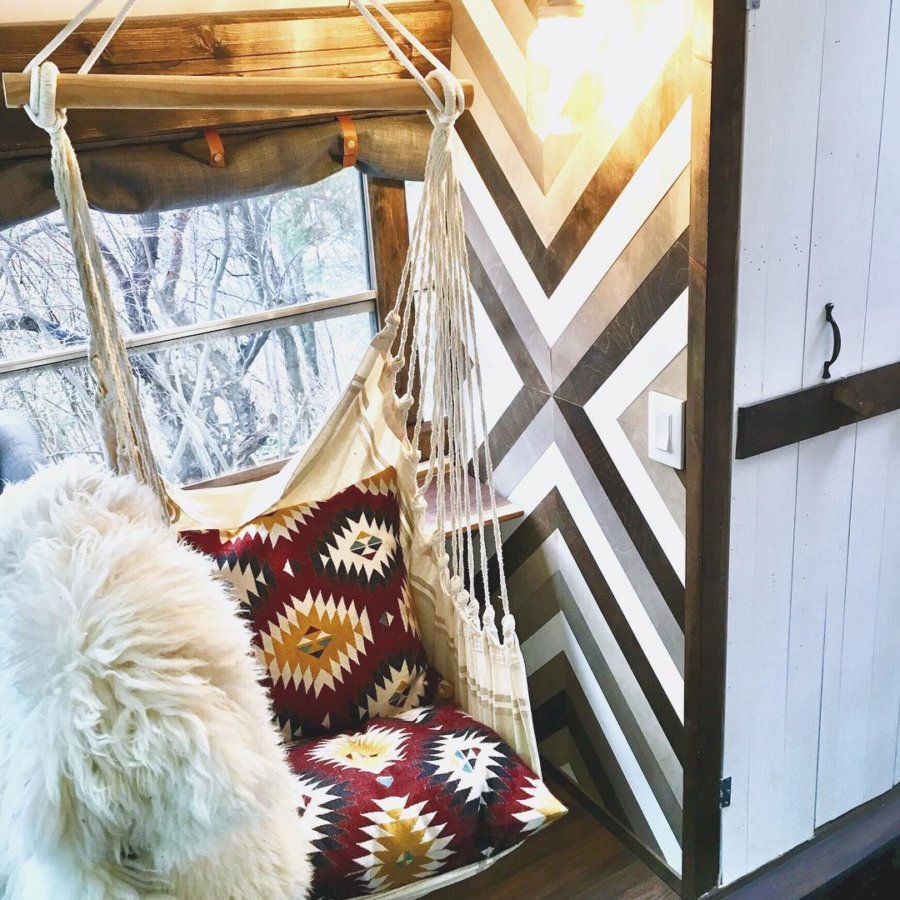
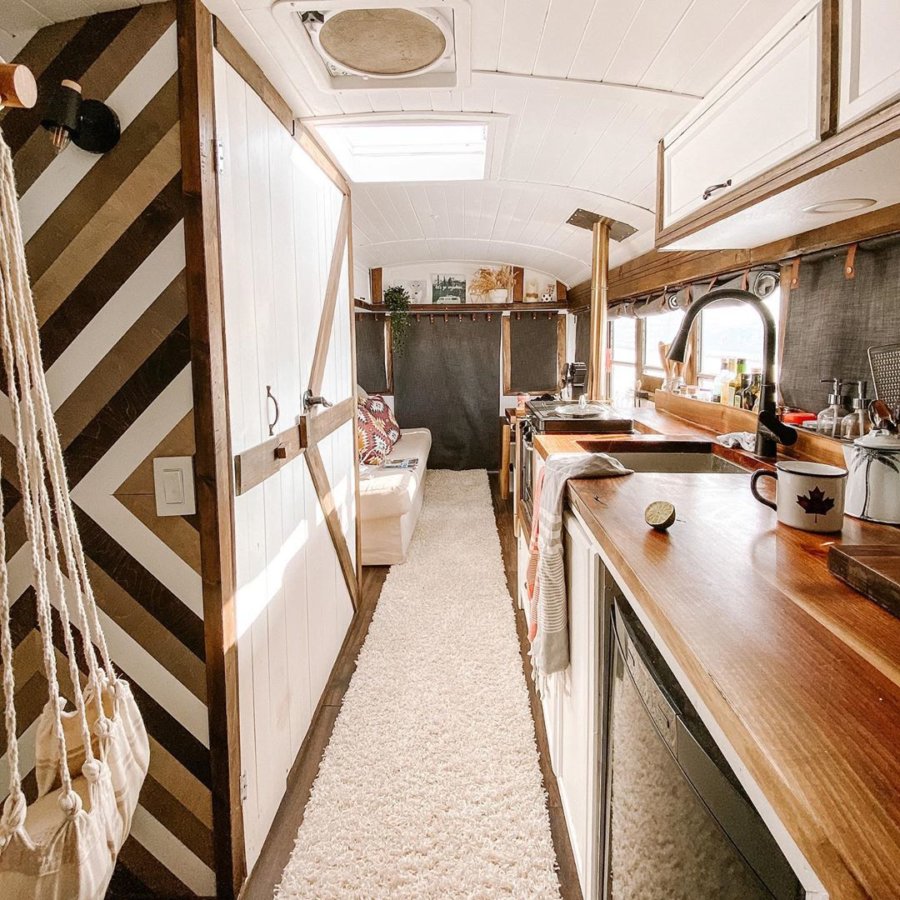

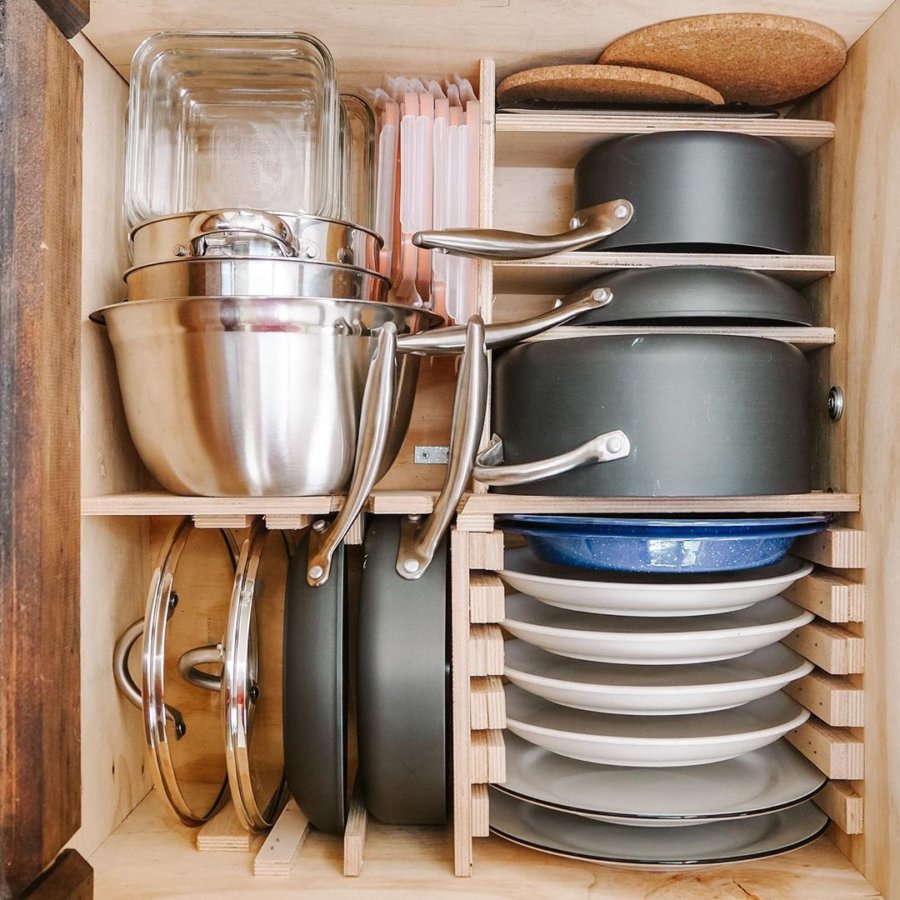
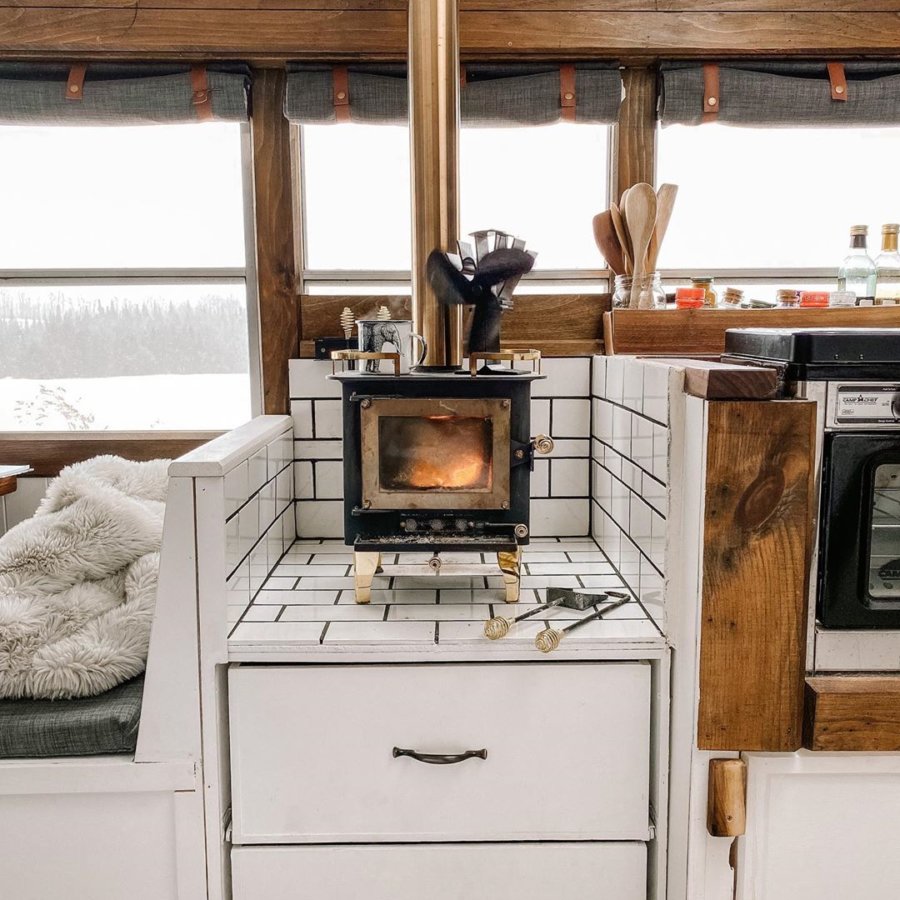
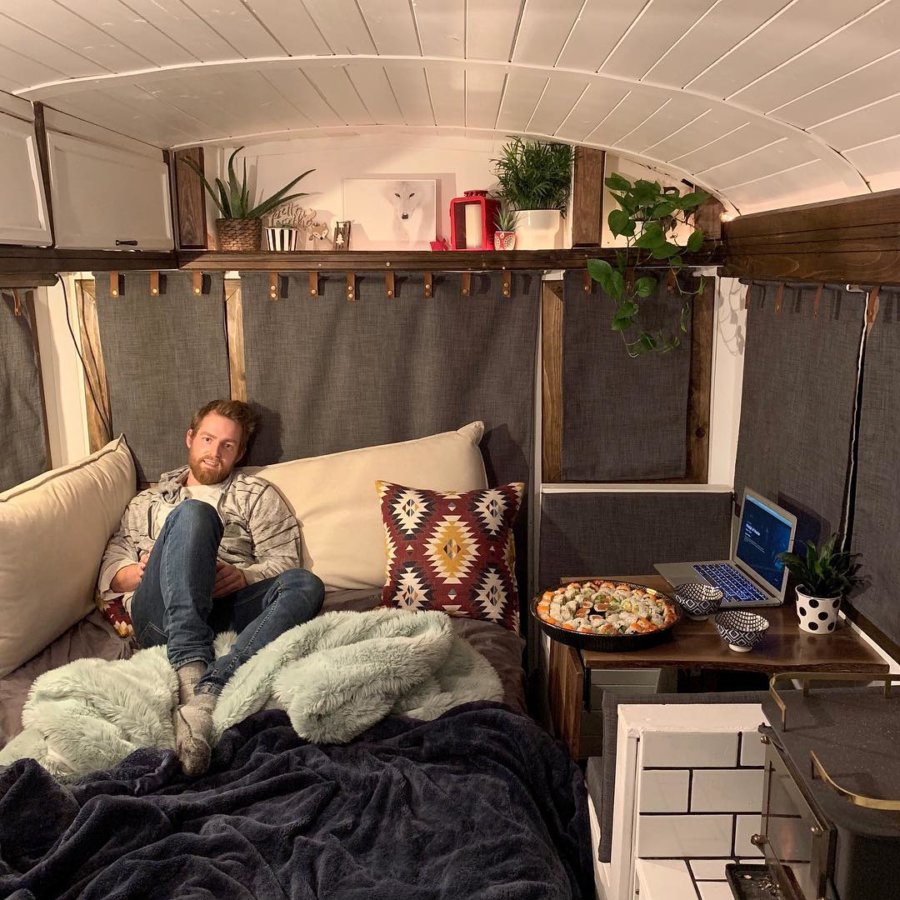
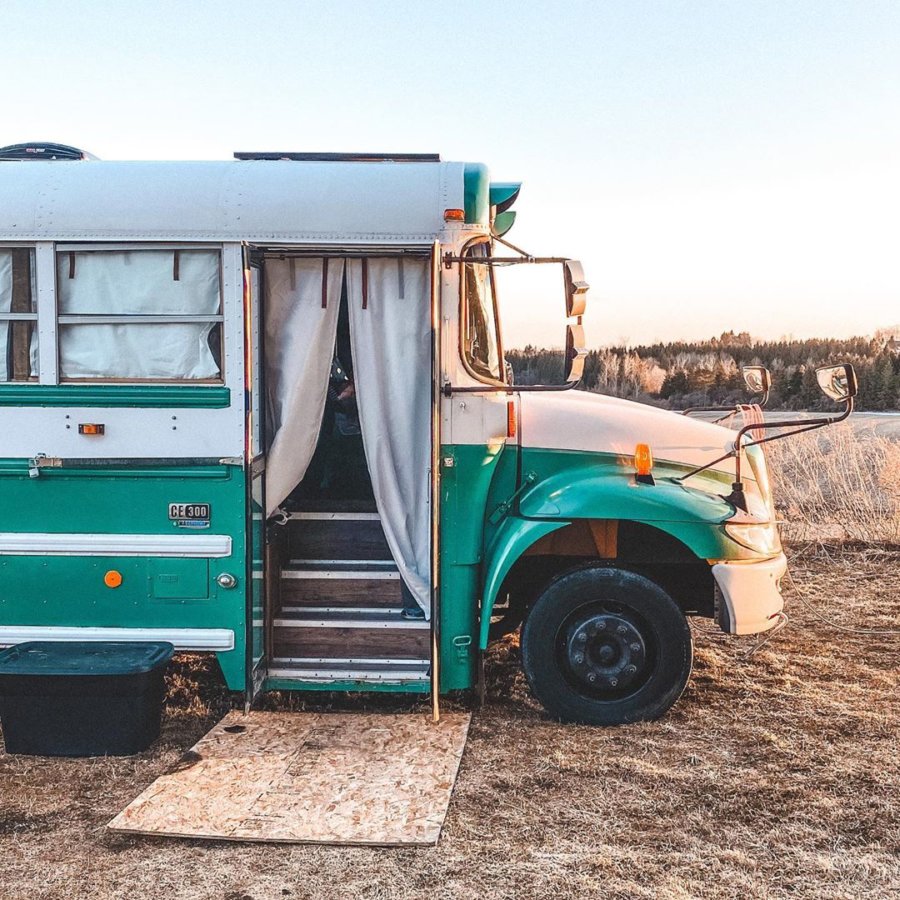
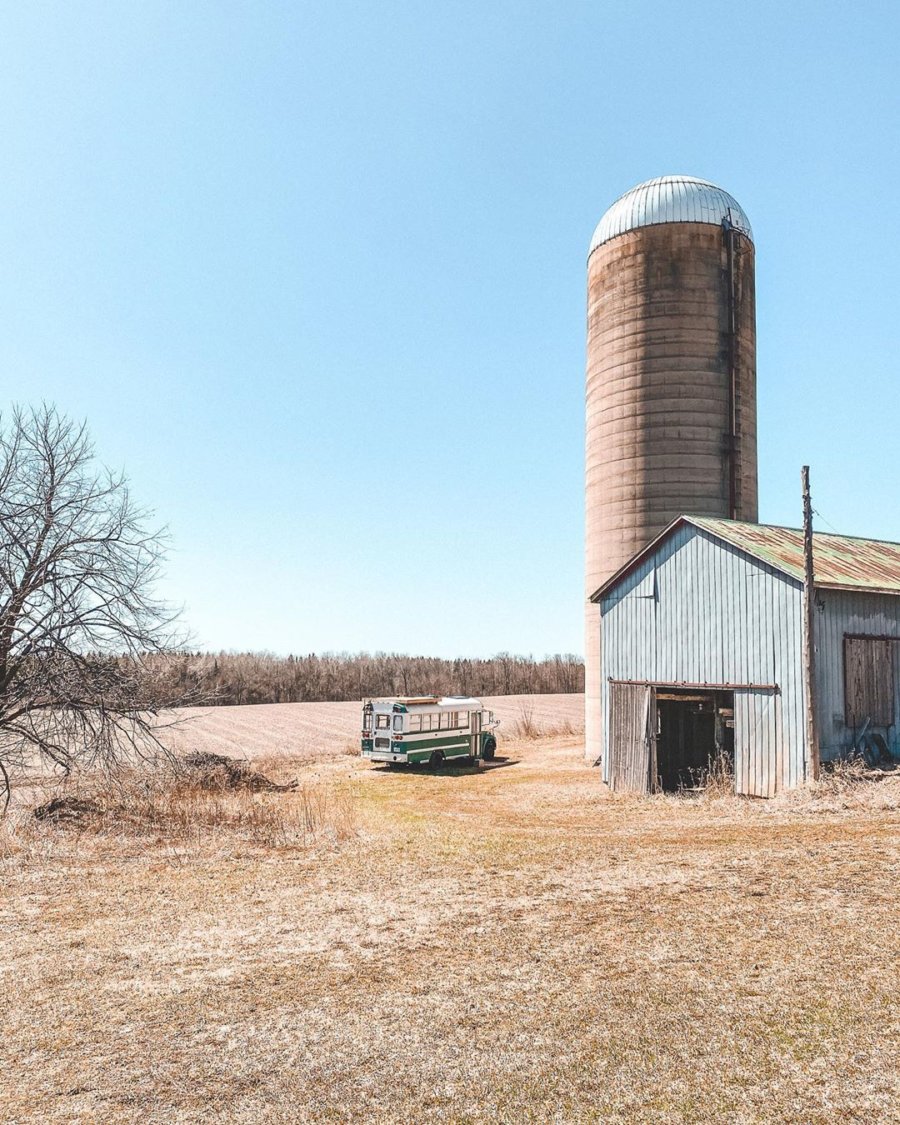
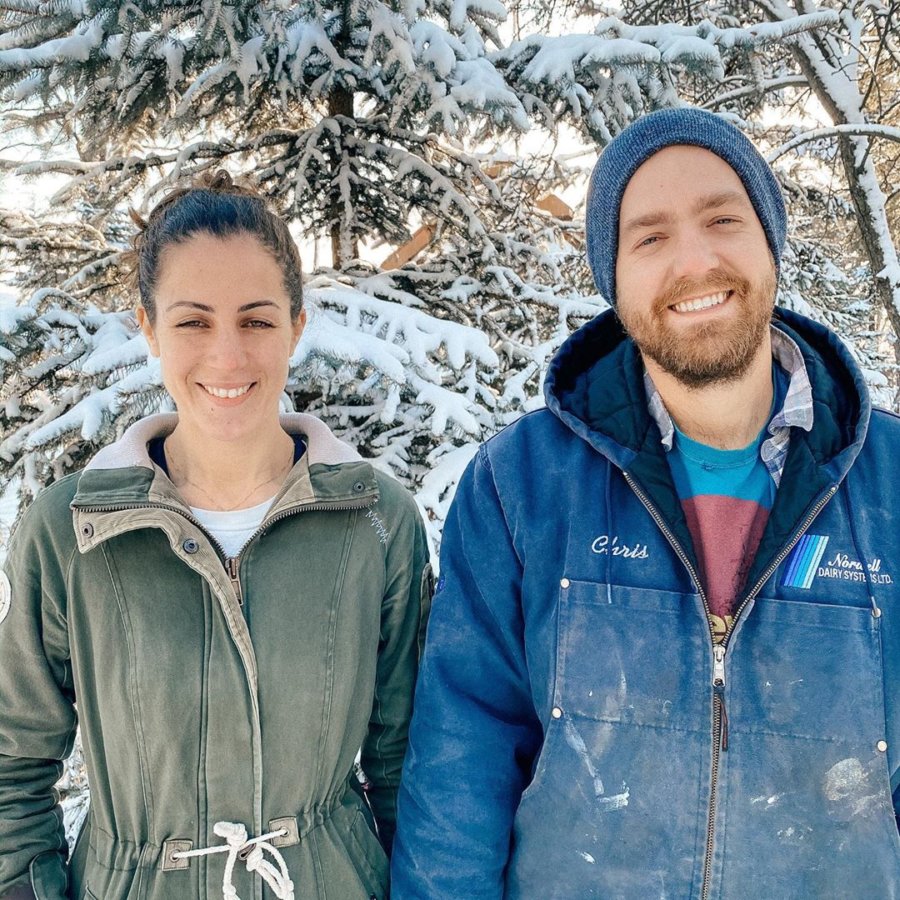



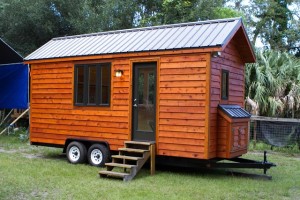

Do wish this couple well… safety & good health. Bus is lovely. Tiny stove = way too cute! Happy travels.
Agreed on the tiny stove!
Is the woodstover over the wheelwell? or could you have an exterior door to those drawers beneath it that would permit you to load it from the exterior of the bus instead of hauling it through the bus?
That’s an idea!
You can tell from the exterior photos that the rear wheel wells are below the floor level. So that’s a viable option…
How does your bed pull out? I see it starts out as a couch but I’d love before and after pictures to see how that works. Also, what kind of mattress did you use? or is it just a bunch of cushions? Is it actually comfortable sleeping like that with two people?
Having a good bed is a big deal for me in my conversion as I have really bad back issues. That being said I also don’t want to take up all the space in my bus putting in a nice bed! I’d love to have a couch like yours, it looks so cozy! Hope to hear from you soon.
One of my biggest discoveries in tiny house living is that THREE CRIB SIZED MATTRESSES make almost exactly a FULL SIZED BED…they can be stacked and they can be spread in a T-SHAPE that can make seams in different locations than just three in a row.
Wow! I had no idea, Mary! Brilliant.
I was wondering if you can tell me where you purchased your woodstove? Was it from a company in Quebec? I just bought a converted bus and I’m looking to put a woodstove in . I am also from Canada. Do you have any insight pros and cons regarding the stove? Did you find that the stove is affordable?
Hi Julie — I think most people get their stoves from Cubic Mini Woodstoves. They seem, generally, to be well-regarded in the tiny house world >>> https://cubicminiwoodstoves.com/
Thank you, much appreciated! We just ordered ours a few days ago.
did you purchase the window covering or make them. Love – love – them!!!